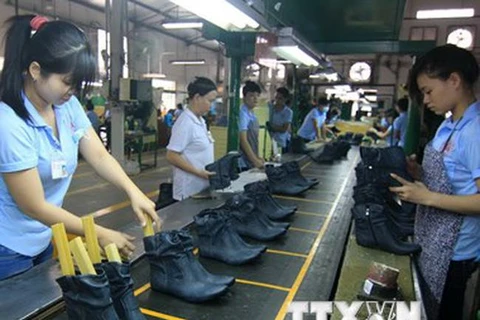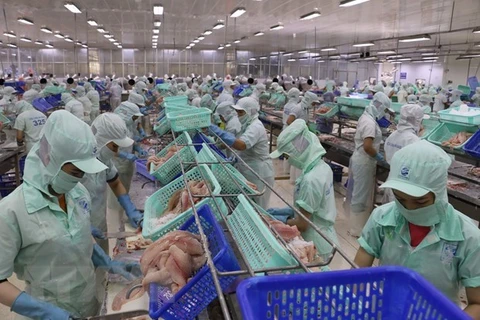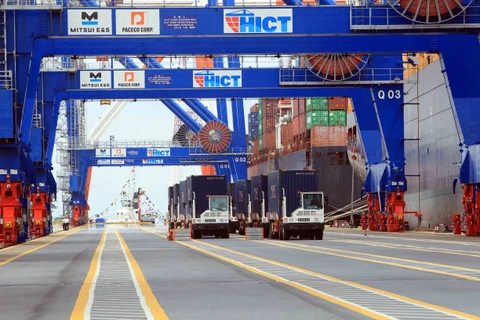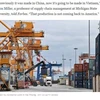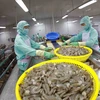Hanoi (VNA) – Two years on from its enforcement, the European Union – Vietnam Free Trade Agreement (EVFTA) has seen outstanding results as many Vietnamese products such as garments, leather footwear, and farm produce have been increasing their market shares in the EU.
Increasing market share for exports
According to the Ministry of Industry and Trade (MoIT), Vietnamese enterprises have been capitalising on the EU - Vietnam Free Trade Agreement (EVFTA) to boost shipments to the EU.
Ngo Chung Khanh, Deputy Director of the MoIT’s Multilateral Trade Policy Department, said that commodities previously subject to high tariffs now benefit from tax cuts under the EVFTA and have recorded strong export growth.
Despite the fact that the EU is a demanding market, Vietnamese businesses have managed to satisfy strict technical requirements, showing a change in mindset to meet the EU’s demand, he noted.
Tran Thanh Hai, Deputy Director of the MoIT’s Foreign Trade Agency, said the EVFTA, taking effect on August 1, 2020, has created a substantial demand for exports, which have increased almost 15% to about 83 billion USD over the last two years.
He added most items exported to the EU posted fast growth during the period, especially steel (200%), coffee (75.2%), and cashew nuts (55.8%). Others shipped in large volumes before the deal took effect, like textiles and garments, footwear, and wood products, have also enjoyed growth of 10-15%.
Only mobile phones and components have declined in export revenue due to the COVID-19 pandemic.
Le Hang, director for communications at the Vietnam Association of Seafood Exporters and Producers (VASEP), said despite the pandemic’s impacts, aquatic product exports had recovered considerably, rising 8% year-on-year in 2020 and continuing to recover in 2021.
By the end of this year’s second quarter, the EU was one of the three largest importers of Vietnam’s aquatic products. She added that thanks to the EVFTA’s preferential tariffs, aquatic product exports rose 40% to nearly 700 million USD. In contrast, shipments of major products rose 30-39%, with tra fish revenue doubling from a year earlier.
She also pointed out certain challenges to aquatic product exports to the EU, including rules of origin, the “yellow card” warning against illegal, unreported and unregulated (IUU) fishing, inflation in the EU, competition with other shrimp exporters such as India and Ecuador, and the market’s strict requirements.
Hang called for the MoIT’s support for enterprises to optimise preferential tariffs and comply with rules of origin to remove obstacles to aquatic product exports.
The trade deal has enabled many Vietnamese enterprises to stand strong through the pandemic over the last two years, Luong Hoang Thai, Director of the Ministry of Industry and Trade’s Multilateral Trade Policy Department, told the Vietnam News Agency.
He said that Vietnam’s exports to the EU increased 6.2% to 39.75 billion USD in the first year after the EVFTA became valid (from August 2020 to July 2021).
Ten months into the second year of the agreement (from August 2021 to the end of May 2022), the shipment volume soared 39.71% to 36.8 billion USD, with significant growth seen in many of Vietnam’s key export items, for example, textile-garment (16.7%), rice (42.9%), pepper (81.3%), aquatic products (22.7%), and machinery (20.9%).
Thai noted that the percentage of Vietnamese exporters using the certification of origin to reap preferential duties provided by the EVFTA expanded from 14.8% in the first year to 20.7% in the second year.
He further cited that last year, Vietnam ranked 11th among exporters to the EU globally. In Asia, the country came fifth, only after China, Japan, the Republic of Korea and India.
He said that it showed Vietnam’s heightened position in the EU market, given that it is a very demanding market with high-quality requirements.
Now the EU is also Vietnam’s third largest importer of agricultural products. According to the Ministry of Agriculture and Rural Development, two-way trade of agricultural, forestry and aquatic products grew from 4.3 billion USD in 2015 to 4.5 billion USD in 2020.
The figure rose further after the EVFTA came into force, to 5.2 billion USD in 2020, up 15.56% from a year earlier. It totalled 2.66 billion USD in the first five months of this year, a year-on-year surge of 26%. As a result, Vietnam’s shipments stood at 2,145 billion USD, up 36.6% year-on-year.
Many agricultural products posted double-digit growth, including coffee, aquatic products, vegetables and pepper, while rice enjoyed a triple-digit jump.
Limitations remain
Vice President of the Vietnam Academy of Social Sciences (VASS) Dang Xuan Thanh said despite the obvious benefits brought by the EVFTA, the optimization of incentives offered by the deal had not met expectations.
He cited examples such as Vietnam’s exports still focused on some traditional markets, and the mechanism for linking localities with Vietnamese representative agencies abroad for trade and investment promotion remains incomplete.
Regarding the impacts of the EVFTA on Vietnam’s trade and investment, researcher Hoang Xuan Trung from the Institute for Europe Studies highlighted that bilateral trade increased by 14.5% year-on-year in 2021 to 57 billion USD, and 14.6% in the first six months of this year to 31.7%.
However, he pointed to arising challenges, such as the limited capability of Vietnamese enterprises to make the best use of available incentives under the FTA, the increase in trade frauds in the digital trade environment, trade protection measures imposed by the EU against Vietnamese goods, and unforeseeable changes in the world security situation./.

